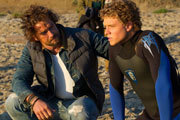Surfing is way more than a modern fad - it was invented hundreds of years ago by the Pacific islanders of Polynesia. Kidzworld takes a look at the science behind the wettest sport the summer has to offer.
How Waves are Formed
When wind blows over the vast expanses of the open water, it creates waves. Three factors influence how big those waves are - the speed of the wind, distance the wind travels over the water (also known as "fetch") and the length of time it travels for. The biggest waves are created by storms far out at sea. They start out as huge, choppy waves and gradually decline into strong, smooth peaks (swell). The swell drags against the ocean floor as it gets nearer to the beach. That dragging causes friction, which causes the wave to grow taller, slow down and eventually break.
Breaking Up is Hard to Do
The shape of the ocean floor and the direction of the wind are the two main factors that cause a wave to break (crash). The best surfing waves are usually caused by underwater features like sand banks, rocky points or reefs. To get the hollow tubes that surfers love, the ocean floor has to slope steeply. Waves tend to break more gently and farther out if the slope of the ocean floor is gradual. Surfers also prefer it when the wind blows from the beach out to the sea, which is called offshore because it helps to maintain clean waves, which are better to surf. If the wind blows from the ocean to the beach (onshore) or across the beach (cross-shore), it will cause the waves to be messy and choppy.
Riding the Wave
Balance is the key to surfing. The center of gravity is towards the tail of the surfboard. To ride a wave, the surfer has to straddle the center of gravity. If the surfer's weight is too far toward the nose of the board, the board will tip forward and the nose will sink. If the surfer's weight is too far towards the tail, the board will tip and the tail will sink. The surfer wants to catch the wave just as it is breaking, which is when it has maximum velocity (speed). In order to catch the wave, the surfers' momentum must be equal to the wave's momentum. When this happens, the surfer will feel the board being carried along by the wave. The rider stands and uses balance and the shifting of his body weight to control his direction.
Did U Know?
- Some Australian universities offer degrees in "Surf Science and Technology".
- Olympic medalist Duke Kahanamoku is often credited as having introduced surfing to the world.
- Surfboards were originally made of wood but most are now made from polyurethane foam and then wrapped in fiberglass.
Related Stories:

































